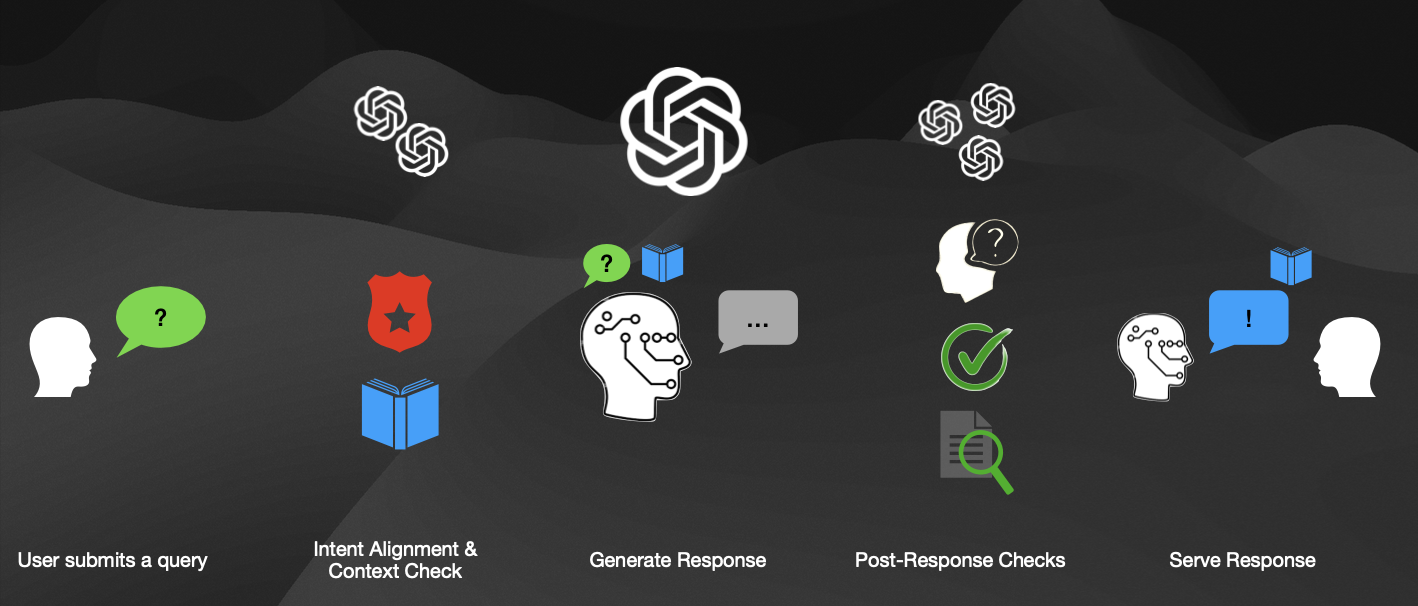
Reducing Hallucinations in LLMs
The Growing Challenge of AI Hallucinations
In today's AI-driven world, Large Language Models (LLMs) have become integral to many business operations. However, with their impressive capabilities comes a significant challenge: hallucinations. These are instances where AI models generate plausible-sounding but factually incorrect or fabricated information. For businesses relying on AI for customer service, content generation, or decision support, these hallucinations can pose serious risks to credibility and operational efficiency.

Understanding The Sentinel Framework
The Sentinel framework introduces a revolutionary approach to managing AI responses through a sophisticated system of checks and balances. Think of it as having a team of vigilant guards watching over your AI system, each with specific responsibilities to ensure accuracy and reliability.
The Two-Tier Guardian System
1. The Pre-Response Guardian: Self-Reflectors
Before generating any response, our self-reflectors act as the first line of defense:
- Intent Analysis: Ensures that every user query aligns with the system's purpose and capabilities
- Context Verification: Confirms that the system has access to relevant and sufficient information to provide an accurate response
- Scope Assessment: Determines whether the query falls within the AI's authorized knowledge boundaries
Here's how you can implement a basic intent alignment check:
# Intent Alignment Check
intent_alignment = client.beta.chat.completions.parse(
model=model_to_use,
messages=[
{"role": "system", "content": """You are evaluating if a user query aligns with contract analysis.
Alignment Status:
- ALIGNED: Query is directly related to understanding, interpreting, or clarifying contract terms
- NOT_ALIGNED: Query is about general business, weather, or other non-contract topics"""},
{"role": "user", "content": scenario.query}
],
response_format=IntentAlignmentResult
)
intent_result = intent_alignment.choices[0].message.parsed
This step is crucial for ensuring that the AI is only responding to queries that are relevant to the system's purpose, and prevents adversarial prompts from being used.
2. The Post-Response Validator: Self-Evaluators
After a response is generated, our self-evaluators conduct thorough quality checks:
- Hallucination Detection: Uses advanced scoring mechanisms to identify and flag potential fabrications
- Response Accuracy: Measures how well the response aligns with verified information
- Context Utilization: Ensures the response makes appropriate use of available reference material
Here's how you can implement a basic hallucination check:
# Hallucination Check
hallucination_check = client.beta.chat.completions.parse(
model=model_to_use,
messages=[
{"role": "system", "content": """Analyze if the response contains any information not supported by the context.
Hallucination Level Scale:
5 (NO_HALLUCINATION) - All information is directly supported by the context
4 (MINIMAL) - Tiny details might be inferred but core information is supported
3 (MINOR) - Some details are inferred but main points are supported
2 (SIGNIFICANT) - Major details are unsupported by context
1 (SEVERE) - Response contains mostly fabricated information
Look for fabricated or assumed details."""},
{"role": "user", "content": f"""Query: {scenario.query}
Context: {scenario.relevant_context}
Response: [Simulated response based on context]"""}
],
response_format=HallucinationCheckResult
)
This simple implementation uses semantic similarity to validate responses against the provided context.
Real-World Impact
Case Study: Product Marketing
Marketing teams using AI for content generation have seen a 75% reduction in compliance-related revisions. The Sentinel framework automatically validates generated content against terms and conditions, ensuring all claims are substantiated.
Case Study: Data Analytics
Organizations using AI for real-time data analysis have achieved 95% accuracy in generated reports. The system continuously cross-references generated statistics with live data sources, preventing the presentation of outdated or incorrect information.
Implementation Benefits
- Enhanced Trust: Build confidence in AI-generated outputs through systematic verification
- Reduced Risk: Minimize the potential for misinformation and associated business risks
- Improved Efficiency: Automate the validation process while maintaining high accuracy standards
- Scalable Solution: Adapt to growing data volumes and evolving business needs
The Future of AI Reliability
As AI continues to evolve, the importance of frameworks like Sentinel becomes increasingly critical. By implementing these guardrails, organizations can harness the full potential of AI while maintaining the highest standards of accuracy and reliability.
Getting Started
Implementing the Sentinel framework in your organization's AI systems is a straightforward process that can be customized to your specific needs. Our team of experts can guide you through the integration process, ensuring your AI applications deliver consistent, accurate, and trustworthy results.
Conclusion
In an era where AI accuracy can make or break business success, the Sentinel framework offers a robust solution to the challenge of AI hallucinations. By implementing this comprehensive guard system, organizations can confidently deploy AI solutions while maintaining the highest standards of information accuracy and reliability.
Ready to enhance your AI applications?
Schedule a personalized demo and discover how we can help secure your AI future.
Contact our team